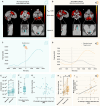REM sleep quality is associated with balanced tonic activity of the locus coeruleus during wakefulness
- PMID: 40069818
- PMCID: PMC11900061
- DOI: 10.1186/s12929-025-01127-9
REM sleep quality is associated with balanced tonic activity of the locus coeruleus during wakefulness
Abstract
Background: Animal studies established that the locus coeruleus (LC) plays important roles in sleep and wakefulness regulation. Whether it contributes to sleep variability in humans is not yet established. Here, we investigated if the in vivo activity of the LC is related to the variability in the quality of Rapid Eye Movement (REM) sleep.
Methods: We assessed the LC activity of 34 healthy younger (~ 22y) and 18 older (~ 61y) individuals engaged in bottom-up and top-down cognitive tasks using 7-Tesla functional Magnetic Resonance Imaging (fMRI). We further recorded their sleep electroencephalogram (EEG) to evaluate associations between LC fMRI measures and REM sleep EEG metrics.
Results: Theta oscillation energy during REM sleep was positively associated with LC response in the top-down task. In contrast, REM sleep theta energy was negatively associated with LC activity in older individuals during the bottom-up task. Importantly, sigma oscillations power immediately preceding a REM sleep episode was positively associated with LC activity in the top-down task.
Conclusions: LC activity during wakefulness was related to REM sleep intensity and to a transient EEG change preceding REM sleep, a feature causally related to LC activity in animal studies. The associations depend on the cognitive task, suggesting that a balanced level of LC tonic activity during wakefulness is required for optimal expression of REM sleep. The findings may have implications for the high prevalence of sleep complaints reported in aging and for disorders such as insomnia, Alzheimer's, and Parkinson's disease, for which the LC may play pivotal roles through sleep.
Keywords: 7 Tesla functional magnetic resonance imaging; Aging; Locus coeruleus; Sleep.
© 2025. The Author(s).
Conflict of interest statement
Declarations. Ethics approval and consent to participate: This study was approved by the faculty-hospital ethics committee of ULiège. All participants provided written informed consent and received financial compensation. Consent for publication: Not applicable. Competing interests: All authors declare no competing interests.
Figures



References
-
- Morin CM, Drake CL, Harvey AG, Krystal AD, Manber R, Riemann D, et al. Insomnia disorder. Nat Rev Dis Prim. 2015;1:1–18. - PubMed
-
- Crowley K. Sleep and sleep disorders in older adults. Neuropsychol Rev. 2011;21:41–53. - PubMed
-
- D American Psychiatric Association, AP Association. Diagnostic and statistical manual of mental disorders: DSM-5. Washington, DC: American psychiatric association; 2013.
-
- Van Someren EJW. Brain mechanisms of insomnia: new perspectives on causes and consequences. Physiol Rev. 2021;101:995–1046. - PubMed
-
- Koshmanova E, Muto V, Chylinski D, Mouraux C, Reyt M, Grinard M, et al. Genetic risk for insomnia is associated with objective sleep measures in young and healthy good sleepers. Neurobiol Dis. 2022;175:105924. - PubMed
MeSH terms
Grants and funding
- T.0242.19/Fonds pour la Formation à la Recherche dans l'Industrie et dans l'Agriculture
- T.0238.23/Fonds pour la Formation à la Recherche dans l'Industrie et dans l'Agriculture
- J. 0222.20/Fonds pour la Formation à la Recherche dans l'Industrie et dans l'Agriculture
- ARC SLEEPDEM 17/27-09/Fédération Wallonie-Bruxelles
- 2019/0025/Fondation Recherche Alzheimer (SAO-FRA, BE)
LinkOut - more resources
Full Text Sources

